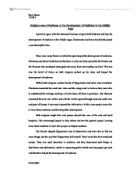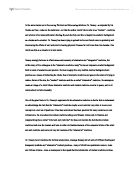Even though reproduction was mostly a religious concern; human and medical methods were also accepted. (Wiesner p.132). Then, came the theory of the “four bodily humors”. This assumption presumed that human body was composed of four principal elements; phlegm, black bile, yellow bile and blood. They then believed that these humors determined personality and that diseases were caused by disproportions between them (Wiesner p.134). Thus treatments such as diets, drugs or blood letting were given in order to try to reestablish what they thought to be an imbalance of humors (Wiesner p.135).
The tree main western spiritual groups took their beliefs from roughly the same sources. The first important work that influences their convictions was written by a Greek named Galen who was inspired by Aristotle and Hippocrates. This guy, born in 130 of the Common Era, spent most of his life in Rome within the Roman Empire and died in 200 of the Common Era (Wiesner p.133). His findings, translated from Greek, were so large and touched so many subjects, that they influenced western civilizations for centuries (Wiesner p.133). One of his supporters, Avicenna (980-1037), an Islamic medical writer, affirmed that women’s apparatus of reproduction was similar to men’s penis except that it was smaller and inward (Avicenna extract in Wiesner p.140). Men and women were both thought to have sperm (Avicenna extract in Wiesner p.140). These two sperms were supposed to mix together in order to engender a life and then, the body of the “seed” was formed by coagulation of women’s menses blood (Avicenna extract in Wiesner p.140). Another philosopher, Constantine the African (1065-1085), believed in diabolic spells that could interfere in intercourse and reproduction (Sigerist in Wiesner p.141). He also mentioned various remedies that could cure these “sorceries”; “Sprinkle the walls of the house with dog’s blood, and it will be liberated from every spell…” (Constantine in Wiesner p.141). The most exuberant savant of this time was probably Trotula of Salerno. She was a mysterious woman who might have lived in the 12th century because we found many treatises signed by her name at this period (Wiesner p137). She declared that men were, by nature, hot and dry while women were cold and wet (Wiesner p.143). Women, being weaker than men, were more subject to catch diseases of any kind than their male counterpart (Wiesner p.143). But she also stated, and it was afirst, that fertility was mired as often by men than women (Wiesner p.144). Inspired by Galen and Hippocrates, she reached a largeamount of topics; how to have masculine offspring, the different stages of the baby once conceived and menstruation in women. These three medieval intellectuals greatly affected western societies for many generations.
In our days, medicine is far more advanced than it was in the middle ages. But we should not take it for granted though, by saying “our scholars are more intelligent then their past compeers” because it is only relative. According to the chapter 7 in the section sources and method of Medicine and Reproduction in the Middle Ages, “Scientific knowledge is shaped by people pre-existing ideas”. Because populations of the Middle Ages were uneducated and did not know much about medicine, “intellectuals” and priests were considered to be really advanced in this domain. Their methods were applied, whether they could cause great injuries or not. Today, in western societies, most people are educated and have a basic knowledge of medicine. If we compared ourselves with the actual doctors in medicine, we don’t know much either. In studying history it is now possible to realize that as the objectivity of societies grow, the potential of knowledge becomes higher. Who knows, maybe that in a thousand years from now we will be chimpanzees to the new generation.
The human being is really interesting to study. In history, we rapidly realized that we are the same than our ancestors and that we differ only from the environment in which we live. Today, we have different cultures, knowledge and technologies that make us think differently. However we still have the same identical nature than people from the Middle Ages. Humans have always tried to cure or to hurt each other, to make love or to create wars but moreover, to find senses to their existences.
Bibliography:
Avicenna The Canon of Medicine “Sexuality and Medicine in the Middle Ages”, Cambridge, Policy Press, Blackwell Publishing Ltd, 4 pages, 1988
Constantine the African Treatise on Impotence “A Source Book in Medieval Science”, Cambridge, Harvard University Press, p. 768-769, 1971
Trotula of Salerno The Diseases of Women “A Source Book in Medieval Science”, Cambridge, Harvard University Press, p. 761-766, 1971
Wiesner, Merry E. and al. Discovering The medical Past: A Look at the Evidence. New York : Houghton Mifflin, 2003







